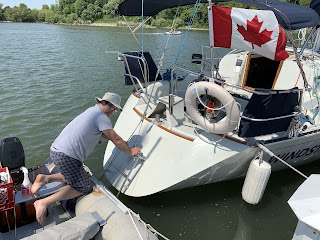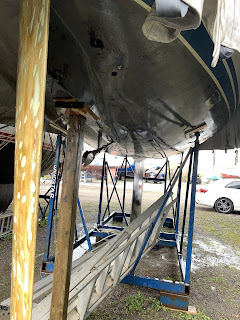under Construction
September 2021
The DC setup on Windstar has evolved to a point where it works very well for how I use the boat. The evolution is covered over many wordy and poorly-written posts over several years so it is probably worthwhile to summarize the setup in its current form.
Batteries and associated hardware.
- 2 ea Enerwatt WPL31 LiFePo batteries, 110AH each.
Saves a tremendous amount of weight, charges very quickly and is very easy to remove for winter storage. Most significantly, the LiFePo technology permitted me install the required usable house bank capacity within the existing (in fact reduced) space. There is a great deal of misinformation, misunderstanding, and opinion-informed opinion on the technology. Sign of the times perhaps. In my use-case, 200 usable amp hours was required. This would require 4 group 31 lead acid batteries (at 65 lb ea) vs two LiFePo batteries at 27lb ea. Windstar does not realistically have the space for 5 lead acid batteries.
- 1ea Group 51 AGM start battery.
Much more compact than the previous battery, which enabled a very small total footprint and short cable runs.
- 2ea Bluesea 2151 MBRF fused battery terminals
expensive as are the fuses but simple to install and compliant with ABYC best practices and common sense.
- 1 ea bluesea 2127 buss bar (for grounds)
Good practice and well organized, this simplifies the battery monitor and shunt installation.
- Bluesea 8690 Battery management Panel
A very well thought out design for small yachts. The Stock 1-or-2-or-both setup really didn't make a lot of sense.
- Victron BMV700 Battery monitor
This is a drop-in replacement for the stock analog meter's mounting hole but requires some reconfiguration of the ground wiring. The monitor is quite clever and useful, with excellent documentation. The higher end models have greater functionality and I would likely choose one of those if I were to do it again.
- 2 ea DIY 00 copper buss bars to connect the house batteries in parallel, DIY polycarbonate guard for positive rail and connections.
Charging
- Stock Hitachi/yanmar alternator
Before I considered the addition of solar charging, I explored an alternator upgrade and I found it didn't make a lot of sense for my use. These automotive type alternators are widely considered a poor choice for charging deep cycle banks, and have issues with overvoltage triggering of LiFePo's BMS. This is addressed via a DC:DC charger, which manages the charge profile. The unit I chose can supply only 25a, wihcih is below the capability of the alternator. While charge time is sacrificed, this means that the alternator never sees a heavy load. The unit delivers its 25A at idle. I am not considering any change to the alternator as upgrades are costly, add complexity, and impose additional loads on the engine, and with the solar panel active, I have found no need for faster alternator charging.
- Xantrex truecharge 20+ AC charger (came with the boat)
While a 20a charger cannot provide enough current to exploit the LiFePo batteries fast charging capability, hoewever this is of no consequence so far in my situation. (similar to the alternator)
- 1ea Renogy 175w semi flexible solar panel.
This panel was the largest that would fit on my bimini. I expected it to be be barely adequate to extend my cruising range, and inadequate for energy independence, so I purchased an additional 50w panel with the intention of mounting it on the dodger. Much to my surprise, the 175w panel alone has proven to be more than adequate, and has performed reliably all season. It was able to exceed its rated output occasionally and in summer, it generated more electricity than I was led to expect.
- 1ea Renogy DCCS50 combined mppt controller, DC:DC charger, ACR, with optional bluetooth dongle.
The the very basic indicator lights are not as user friendly as one might like, (especially buried in a locker)and the bluetooth app is a bit clunky. While the DCCS50 has an ethernet port, its remote monitoring or programming potential is not yet developed. this isnt a big problem, but better monitoring/interface would be nice.
This unit has the advantage of incorporating several functions in one relatively compact enclosure, simplifying installation and saving space. In addition to the interface previously mentioned, the unit imposes a low limit of 25A on the DC:DC charger/alternator. Would a higher output charger improve my liveaboard experience? I don't think so, as I don't charge via the engine at anchor. Is this constraint actually a benefit? This was not part of the decision to buy, but it may be. The 25a limit probably protects the alternator from the very high charge acceptance of the lithium battery bank, much as a programmable regulator might. Does it matter? I don't know, but having the smallish alternator and 18hp engine experience less heat and load can't be a bad thing. If I were to do it again I would at least consider a separate mppt controller and higher current DC:DC charger and ACR, and would probably come to the same conclusion based in the elegance and simplicity of the integrated unit.
This raises an interesting observation. If the solar charging is adequate and reliable, the other charge sources (at a paltry 20 and 25a) can be considered as secondary and need not be sized to charge the LiFePo bank at a high rate. My batteries could easily accept 3-4X the charge available from my AC charger or alternator but because the bank has sufficient capacity in reserve, this is not required. Anyone designing a system from scratch might oversize the secondary charge sources, based on the manufacturer's recommendations and big noisy internet wisdom. This would add significantly to the cost. (A large inverter charger or a larger alternator and external regulator are each costly upgrades that vs the convenience and simplicity of additional "buffer" battery capacity. )
I have not yet discharged the bank to 50%, even while "living large" cruising for two weeks. In theory Windstar could get by with only one 110ah LiFePo battery, though this would leave little safety margin.
Unattended, the fridge consumes around 20ah overnight, and this is typically replenished by mid morning in mid-summer here on Lake Ontario.









































































